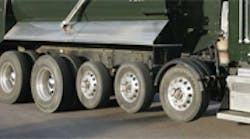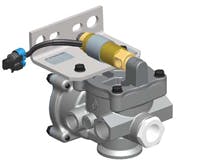For years, truck manufacturers, lift axle builders, and installers have been searching for a fast, reliable, less complicated, and affordable way to control the up and down movement of lift axles.
“Many of today’s lift axles are controlled by either a combination of multiple brake-style relay valves and solenoids or industrial piloted spool valves,” says Andy Lampkin, of Norgren Global Vehicle Technologies (GVT). “Multiple components require additional plumbing and increase the possibility of air leak points, while industrial spool valves are (relatively) expensive and prone to failure in heavy-duty chassis applications. Truck operators have been looking for a way to lift and deploy auxiliary axles quickly and economically and withstand the tough conditions for chassis-mounted components.”
According to Lampkin, a solution is on the way. Norgren GVT has developed a chassis-mounted Lift Axle Control Module (LACM) that can be configured to specific system requirements and is durable enough to withstand the harsh working conditions of off-road equipment. And by using brake-style relay valve technology that maximizes air flow, the LACM can reduce lift axle deployment times.
“In many single-element systems, the LACM has consistently shown as much as a 50% reduction in the time it takes the lift axle to initially lift off the ground and, when deployed, to come to the pressure set by the regulator,” Lampkin said.
He said some manufacturers will pre-plumb new trucks to accommodate the LACM. The device will also be available in the aftermarket for operators who want to retrofit their trucks.
Equipped with all it needs
The LACM is a single device containing an integrated solenoid valve and all the ports required to control the axle. Included are a single main air supply port, two load air-spring delivery ports, two lift air-spring delivery ports and a single regulated supply port. A pressure gauge port is optional.
“We were approached by a truck manufacturer that was looking for a device that would reduce problems in the field and be more cost effective,” said Lampkin.
“They wanted us to come up with a better mousetrap. At the same time, we wanted to address the performance requirements of truck operators in construction and other off-road applications,” he said.
Vocational truckers have long sought ways to increase the carrying capacity of their vehicles while still complying with federal and stat e weight restrictions. Auxiliary axles have been a popular solution.
Depending on how much weight a truck is carrying, the operator may need to have the axle down. If the truck isn’t carrying much weight, the auxiliary axle may be in the raised position.
For steerable lift axles, the axles have to be lifted when the truck goes in reverse. “The raising has to happen quickly because most steerable lift axles can’t be steered in reverse,” said Cully Dodd, engineering manager at Watson & Chalin Mfg., a manufacturer of truck suspension systems. “If the raising doesn’t happen fast enough, the axle wheels may slide sideways, which limits the life of the axles or suspension components.”
Another problem is the amount of time waiting for lift axles to deploy or lower. When a dump or a cement truck is fully loaded, the driver must lower the axles to go over the road to comply with weight regulations. That process can take up to a couple of minutes, reducing the life of the tires or causing flat-spotting, according to Dodd.
“The LACM has high air-flow capability to allow for rapid axle movement,” said Kevin Curtin, GVT engineer. “Drivers will appreciate that speed when the axle is lifted as well as deployed.”
The LACM, which will be commercially available later this year, uses a poppet style valve that is more durable and reliable than other types of valves, according to Lampkin.
Lampkin concluded that the LACM can be outfitted to a particular lift axle’s configuration and operating requirements. “Our product is configurable with various solenoid valve settings, electrical connections, and pneumatic line connections,” he said.
For more information on Norgren GVT’s Lift Axle Control Module, contact [email protected] or visit www.gvt-norgren.com.



